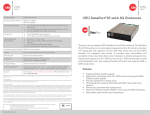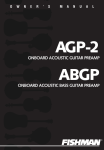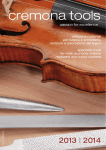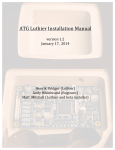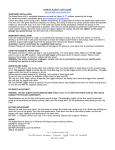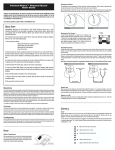Download Installation manual AK15 plus
Transcript
A Installation manual AK15 plus Contents: • Intro • Considerations • Limitations that apply to us all • Objectives • Warranty • Claim • Installation guide • List of contents • Check and inspect the guitar • Prepare the workplace • Prepare the instrument • Woodwork • Pickup installation • Saddle height adjustment • Microphone block installation • Make sure where to place the microphone • Battery Holder installation • Test run • Soundhole control and final assembly • Technical data Your aim is to achieve a warm sound with fat bottom end, a well-defined midrange and sweet, crisp treble. Easier said than done! It may well be that your instrument acousticly reproduces this. But bear in mind when amplified the fat bottom end will possibly mask the definition of the midrange. It will tend to start getting out of control at lower volumes, often causing feedback. Your sweet, clear treble may seem a little harsh just because of the volume you hear it at. Less amplified treble will again suffer from masking effect and the harmonic structure will possibly get lost after a short distance. The choice is your own. Your instrument is unique. There is only one installation procedure – no reset – no slow motion! Limitations that apply to us all It is the objective of every pickup-system for acoustic instruments to capture ‘true’ sound, but how hard we may try, we stay within the borders of sensors, electronics and personal taste... there is no magic formula. Consequently, the ‘sound’ we are looking for remains phantom-like… the search is seemingly unending. However, there is a difference in approach, technology applied, quality of instruments, playing styles and personal perception and preferences. Thus it makes sense to trust in experts (luthiers, repairmen) around you for consultation and recommendation with regard to your instrument, style and listening tastes. Objectives Intro Thank you for choosing AER. Be assured, we have done a lot to achieve this level of performance. We hope that it may change the way you look at things a bit. AER Pick Up systems are made to: • To capture the true sound of the instrument with a maximum of dynamic range - even if it exceeds the dynamic range of the instrument. • To avoid compression and distortion where ever possible • To achieve high volumes combined with low noise components for best possible signal to noise ratio It has been a developing goal to come up with an easy to use, versatile pickup system that follows the acoustic sound of the instrument in its dynamic range, as well as in all its registers. It can be used with all instruments (steel and classic) which allow under saddle pickup installation with string spacings from 10 to 12.5 mm. • To combine more than one source to follow the acoustics with best truth • To focus on tone, practicability and durability rather than convenience The installation is similar to all under-saddle pickup systems. The instrument does not suffer mechanical stress in use or during installation. There is no soldering necessary. • To provide acceptable battery life with focus on supply voltage rather than hours of performance The AK15 plus is a two source, Piezo crystal plus electret condenser microphone endpin pickup system. The two levels are pre-adjustable independently at the pre-amp and controlled with soundhole control (master plus added microphone). Considerations There are many ways how to layout and design a pickup system and still it will not fit all applications, instruments or personal likes. The AK15 plus is what we have to start with. That is to say there is more to come in future, and authentic tone will always be prime priority. As with all AER Products so far, comments are always welcome and valid comments will become part of the product when time allows. Warranty The AK15 plus is warranted to function for a period of two years from the day of purchase. In case of failure due to manufacturing repair, exchange or refund are AER’s only obligations. This does not include consequential damage of misuse, accident or neglect. AER retains the right to makesuch determination on the basis of factory inspection. AER. Audio Electric Research. Christine-Englerth-Strasse 30. D-45665 Recklinghausen www.aer-amps.com page 1 AER. 08/05 A Claim AER and AER-Korea cannot be held responsible for any damages to your pickup or instrument that may result from improper installation. AER recommends installation by qualified personnel only. Your national distributor will be able to recommend someone. • An adequate amount of string pressure on the pickup-crystals is required to effect correct performance. You will find that a minimum 20° break angle is required, if more all the better. If your instrument does not provide this, the string slots will need ramping. Worst case can be a neck-reset or a new bridge. (See saddle height adjustment) • Check that the top bracing does not conflict with the projected cable hole. • Make sure that the bridge is not tilted and the top sunken in. • Check the saddle. Materials: bone, Delrin® or Micarta® require different attention. You may consider getting an replacement saddle to work on, keeping the original untouched. • Make sure that it fits the slot and does not tilt within the slot. There should be no routing required. The pickup dimensions are 1.5 x 1.6 x 68 mm. • Verify that the slot depth (including pickup) does not remain under half the total saddle height. Mismatch can be compensated by chims or removal of material from the bottom of the saddle. • Make sure that the tools are in good shape and sharp! Working with wood needs proper tools. You may find unexpected obstacles where you would normally expect smooth operation. It is not complicated, but it needs experience… and have a plaster handy! • For sure the saddle slot has to be straight and even, the saddle rectangular. However this does not necessarily mean there will not be balance difficulties. In many cases the balance between the strings of the acoustic instruments is not even… the pickup, however properly installed, just reflects this and needs compensation with e.g. Scotch tape. But bare in mind ‘problems are not always what they first appear’. Installation guide A qualified repairman or luthier works with patience and focus. A successful installation requires a reasonable amount of care and attention, and someone who knows what he is doing. However, there are some points to check and verify before an installation should be considered. Please read the instruction carefully and make sure that you understand everything. In case you are not absolutely confident in what you are doing, allow a repair specialist to do it for you! Check the contents of the pickup system to make sure everything is complete! Prepare the workplace: List of contens 1. 1x AK 15 plus Endpin preamp with soundhole control (SHC) Make sure you have enough space around you to place and move your instrument during installation without any problem. 2. 1x Microphone foam-bloc Have an anti skid, soft support, and a proper neck rest ready. 3. 1x Pick Up with protection tube Have your tools to hand. 4. 9V battery Prepare the instrument: 6. 2x Dual-lock™ (tape) size: 25 x 40 mm 1x Dual-lock™ (tape) size: 10 x 25 mm Loosen the strings and clamp them with, e.g. a capo, in the first fret to keep them in place. 7. 3x Cable clamps 8. 2 Screws for battery holder Add-ons 1. 1 AER - ‘Built in’ sticker 2. pencil bag 3. AER strings 4. AER Note pad 5. AER pencil Check and inspect the guitar Remove the string endpins (special bridge pin puller; e.g. www.stewmac.com) and the saddle. Some saddles are pretty tight, similar to being glued in. It needs some skill to remove it either with an edge cutter, pliers or a blade (hold the trapezoid blade with both hands and pick the saddle at the treble side). • Remove the endpin (special endpin grip; e.g.www.stewmac.com). 6. AER sticker • To make use of the soundhole control it needs to be attached! Bracing around the soundhole differs between makers and can conflict with the controls. Check the strings spacing, centre to centre of the string, or middle between a pair, to make sure it matches the ‘AER flex68’ pickup (recommended from 10 to 12.5 mm) always from the middle. Depending on what work needs to be done on your instrument, use paper masking tape to protect the surface of the instrument around the bridge and the endpin… however check the removability of the tape first at a ‘safe’ spot on the instrument… you never know! AER. Audio Electric Research. Christine-Englerth-Strasse 30. D-45665 Recklinghausen www.aer-amps.com page 2 AER. 08/05 A Wood work: Saddle height adjustment: Take a sharp pencil and a ruler and draw a line 1.5mm from the bottom of the saddle. Using a rasp/file, file it down, finishing with sandpaper (80 to 150 grain). Be aware of the saddle material! Bone, Delrin® or Micarta® respond completely different and need proper tools. Take care during the process of sanding. If the saddle is too low you can use a cardboard or wooden shim to compensate. In any case it should be flat and rectangular. There should be no routing required if the slot has a regular length! The width and depth should be sufficient. Should routing be necessary... have it done by someone who knows how! Widen the endpin hole to 12 mm diameter using an endpin reamer. Make sure that it is centered properly and rectangular to the end block. Proper saddle fit and break angle Microphone block installation: Drill a 2 mm hole (for a wider slot use a wider drill) with a ‘ 90° angle through the saddle slot and the top at the edge of the slot. It is immaterial which side is drilled, bass or treble side. Avoid hitting the braces! We prefer treble side to clamp microphone and pu cable. Peel one side of the white-covered foil off the Dual-lock tape and attach it to the microphone block. The cable leaves the block 10 mm parallel to the top side! You can compress the microphone block carefully to secure a proper fit. Make sure where to place the microphone! We recommend the microphone to be placed inside the guitar on the back along the bridge at about 5 cm away from the side (treble) of the guitar. Clean up the inside. Other positions will work too, we find this, however, to be the ‘sweetspot’ for best signal performance at minimum feedback. – Bare in mind, the AK15 plus concept is a mix of sources and the microphone being inside the guitar has the job of enveloping the harmonic structure, rather than the fundamentals. – Battery Holder installation: Pickup installation: Take the pickup out of the protecting tube and feed the thread through the hole in the top from the inside of the guitar. It will fit most saddle slots easily, the slot will not require filling. You can use the thread as a spring to keep the pickup in place. Repeat the installation as with the Microphone Block if you prefer not to screw the battery holder to the top block (screws are included in the package). The recommended position is along the first back brace at the centre, close to the top block. The dual lock tape gives a firm connection with the sythetic rubber glue holding firm, however removable! Make sure the saddle slides easily into the slot, however it should not tilt. Fix the saddle with masking tape to protect the pickup during installation, and use a strip of masking tape to stick the pickup cable inside the guitar to a near top brace, as strain relief. AER. Audio Electric Research. Christine-Englerth-Strasse 30. D-45665 Recklinghausen www.aer-amps.com page 3 AER. 08/05 A time. Also the adhesive tends to react with the wood leaving marks after a while. Position the SHC where you can reach it easily and hide the cable behind a top brace using masking tape. When mounted, the right pot (in direction of the bridge) is the master volume, the left pot (in direction of the head stock) adds the microphone signal. Now mount the endpin preamp and fix the cables inside the guitar with the cable clamps. Insert the strings and bring your instrument up to pitch. That should be it! We all hope you like what you hear! In case of string-balance differences remove the strings again and stick a layer of Scotch tape under the saddle at the position of the string with the low signal. It needs a little experience to predict what will happen when doing this. Test run: Connect pickup and microphone block to the preamp according to colour code and connect the battery. Then connect output jack to an amplifier. Tools you need Even though the trim pots are sensitive, you will have no problem in identifying 4 positions when the pots are turned with a screw driver: Zero (1) - 1/3 (2) - 2/3 (3) - full (4) Settings depend on the guitar body size, the maximum volume you want to achieve and your preference in sound. Make sure, thats microphone volume and master are at maximum at the soundhole control during test run. Factory setting: f.l.t.r. pencil, cutter, wooddrill, masking tape, adjustable wrench, scissors, screwdriver,… Piezo: + 10dB (between pos. 2 and 3) Microphone: + 10 dB (between pos. 2 and 3) Note: AK 15 plus is not made for ‘microphone only’ performance! You will find a surprisingly warm yet strong and clear tone from the piezo due to an suitable electronic environment. The microphone will add definition, vitality and authenticity as well as an ‘acoustic ambience’ that make the sound more natural. Too much microphone however will make the tone ‘hollow,’ whilst piezo at full volume may make microphone use impractical. All this has been experienced without using a feedback buster. Technical Data: If you can hear both signal loud and clear you can install the preamp into the guitar and fix the cable with the cable clamps. Max.Input +10dBV (Piezo) Max.Gain 20dBV Max.Output +10dBV Output Impedance < 50 ohm Noise < -91 dBV, (22Hz - 22 kHz, Gain = 0 dBV, Input shorted Supply Current 5.8 mA (9V Battery) Design Low Noise Class A/B output stage Low Noise FET input stage DC-DC converter Soundhole control and final assembly: 0dBV ~1V Depending upon the construction of the guitar, you may find it necessary to use different materials to underlay or pad the sound hole control. If you can attach it directly to ‘wood’, you can use Superglue to glue the SHC to the appropriate position. We use Loctite 454 gel. Should it be necessary to remove the SHC, a blade can be used without leaving marks! If adhesive tape is used, you may find it falling off from time to Paper masking tape as strain relief, underlay and Sound Hole Control AER. Audio Electric Research. Christine-Englerth-Strasse 30. D-45665 Recklinghausen www.aer-amps.com page 4 AER. 08/05




